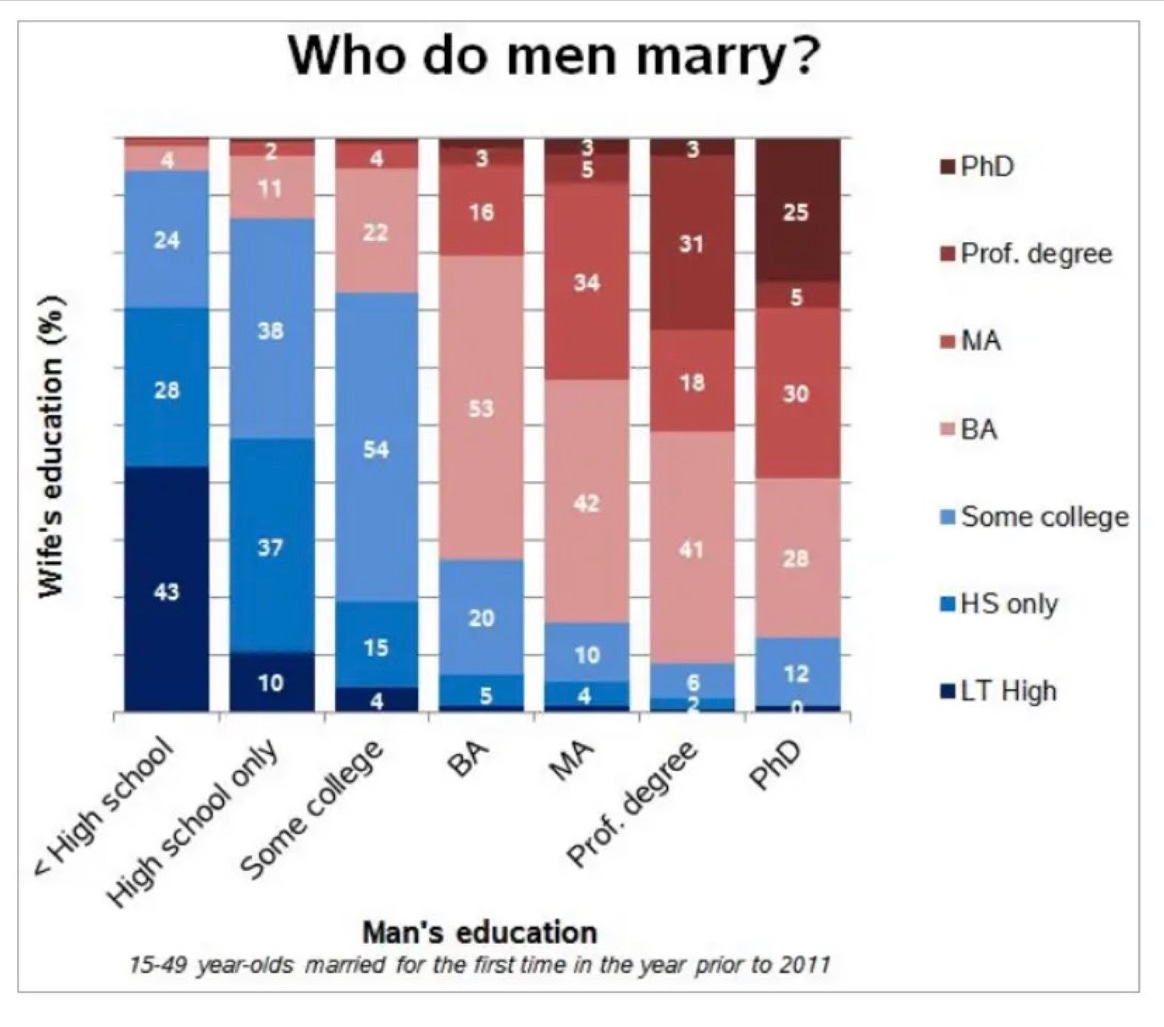We’ve got another long read today. Buckle up, my babies.
Everyone’s talking about how assortative mating and hypergamy are partly to blame for declining marriage rates. But there’s good news here too.
Before we get to that, let’s define our terms.
Assortative mating just means like marries like. People in the US today tend to marry or pair up with people with similar levels of education, income, and attractiveness. The main alternative to assortative mating is hypergamy, or the beauty/status trade. Hypergamy just refers to how people like to “marry up” in terms of status.
So are US marriages more assortative or hypergamous? Well, they’re both. But they’re more assortative.
Since the 1950s, US marriages have been becoming more assortative across a wide variety of factors, including and especially income and education. In 1970, wives made 52% of what their husbands earned. Today it’s up to 78%. People with high incomes marry people with high incomes. Same for education and, as Scott Alexander points out, class. There are a bunch of potential explanations for the rise of assortative mating. But the most obvious one is that people like it.
The big downside to assortative mating is that it exacerbates inequality.
Claire Cain Miller and Quoctrung Bui write:
The Don Drapers of the world used to marry their secretaries. Now they marry fellow executives, who could very well earn more than they do. With more marriages of equals, the country is becoming more segregated by class.
Beauty/status trade marriages facilitate economic mobility. A low-status person can raise their status by marrying into it. Assortative mating drives income inequality by helping to ensure that more low-status people have low-status kids and high-status people have high-status kids.
Assortative mating in the US is not simply two people angling for the highest status partner possible. No, because that would mean that sometimes the woman is higher status. And that, my babies, is emasculating.
As women have gained status, both men and women have stubbornly clung to the idea that the man should have more status than the woman.
For example, opinion polls show that both women and men are much more likely to agree it’s important for a man to be able to support a family financially than it is for a woman. Married women go to tremendous lengths to support the gender status hierarchy. Wives choose lower paying work and work fewer hours to avoid out-earning their husbands. And if they do earn more, they lie about it. Wives who earn more than their husbands do an even greater share of the housework and childcare than the average wife.
Bill Doherty, a marriage therapist and professor at the University of Minnesota, said:
It’s kind of like if he’s shorter than she is, she doesn’t wear heels. It’s in the cultural DNA that if anyone should be bigger, richer, more successful, it should be the man.
That doesn’t mean men want uneducated, low-income wives. Women with more income and eduction are more likely to marry in part because men do enjoy a woman who’s educated and makes money.
But the ideal partnership is one in which both parties have similar levels of income and education but the man has slightly more.
It makes sense for wives to go to great lengths to make their husbands feel manly. There are real consequences to violating these gender norms.
Marriages where wives earn more than their husbands are less happy, have more strife, and are more likely to end in divorce.
Men who earn less than their wives are also more likely to cheat on them.
Financially dependent husbands are more likely to commit domestic violence and tend to be in worse health.
And, breadwinner wives are more likely to use anti-anxiety medications and suffer from insomnia.
Once again, men are punished for performing femininity much more than women are for performing masculinity. And men, in turn, punish their wives for earning more money than them by arguing, doing even less housework, abusing them, and cheating on them.
So, women are earning more money and degrees while men are earning less. And marrying down seems pretty unpleasant. Perhaps not shockingly, fewer Americans are getting married. And according to one paper, 23% of the marriage decline is due to people not wanting the wife to out-earn the husband.
But all is not lost.
Scott Alexander argues that marriages between degreed women and degreeless men used to be as shitty as female breadwinner marriages. But then something changed. As women started earning more degrees than men, these marriages became more normal and thus less stigmatized. As a result, the men in these marriages seem to be acting better.
At some point in the near future women will likely earn more money and more degrees than men. Maybe female breadwinner marriages will become more normal, less stigmatized, and men will calm down and these marriages will be happier and healthier than they are right now.
There’s other evidence from history that female hypergamy is less a human universal and more a classic case of conservatives loving to describe the practices of a short period of aberrant economic prosperity in the 1950s and 60s as “traditional.” If true, this may mean that women’s ascendancy doesn’t have to spell doom for marriage.
Status/beauty trade marriages peaked around the 1950s. In my reading of history, the 50s peak was indeed an aberration. And Alexander points to a paper showing no “period of significant hypergamous marriage by women” in England and Wales 1837-2022.
Marriages have always been pretty assortative, at least since the rise of serfdom and at least among the aristocracy. Women often brought status to their marriages, either through lands, titles, or both. Parents of both men and women looked for high status mates for their progeny.
The “male breadwinner” norm seems to have started during the industrial revolution.
Before that, most lower class women worked to provide materially for their families, from farming with babies on their backs to spinning and brewing beer with toddlers running around the cottage.
It hit its high point in the 1950s when average male wages were weirdly high.
Since then… well I think Richard Reeves, who Freddie was responding to, hits the nail on the head. Men aren’t sure what their role is outside of breadwinner.
So perhaps the male breadwinner model was simply a weird historical blip and as women make more money our model of marriage will adjust accordingly. That would be tight.
I, for one, absolutely love the idea of separating genitalia from what a person is supposed to earn. That is a very stupid idea.
But, while both men and women have always provided materially for families, and the “male breadwinner” norm may be new, it does seem somewhat universal that the buck for material provision does tend to stop with the man.
How easily will the average man accept his wife bringing home the bacon?
For instance, the average man is more status-seeking than the average woman. Money and education are pretty closely tied to status. Men seem to have accepted lower status than their wives when it comes to education. But will they accept it earnings? Maybe they’ll find status elsewhere. Or maybe men will start to care less about status once it becomes rare for a husband to earn more than his wife.
I will say, even if the male breadwinner model is here to stay, it doesn’t make sense to keep women out of the workforce or depress our wages to keep marriage rates high and marriage healthy. “We've heard a lot of rhetoric of late about family values and the traditional breadwinner-homemaker model," said Christin Munsch, the sociologist at the University of Connecticut who ran the cheating study. Justin Murphy recently defended workplace sexual harassment because it supposedly facilitated beauty/status trade marriages. With all due respect, suck Harvey Weinstein’s weird dick Justin. Again, this would be economically ruinous, morally problematic, and wouldn’t even work. Plus, “Actually, relationships are more stable when both people are bringing in income,” Munsch said.
No matter what, boosting male wages is probably a good idea. We have evidence it boosts fertility. And it seems likely to boost marriage rates and help create stable, healthy marriages. Plus, wages are good! The first step, as always, is to get more men (and women!) into good jobs by decriminalizing work. What else to do, I’m not sure. But that seems like a good place to start.
Sex and the State is a newsletter at the intersection of policy and people. Like it? Upgrade to a paid subscription, buy a guide, follow me on Twitter, support me on Patreon, or just share this post 🙏
~~~~~
This ⬇️ is an affiliate link! Sign up today to support me!
Join the reading revolution! Get key ideas from bestselling non-fiction books, distilled by experts into bitesize text and audio. Explore our vast library of over 5,500 titles and stay up-to-date with 40 new titles added each month.

















Share this post